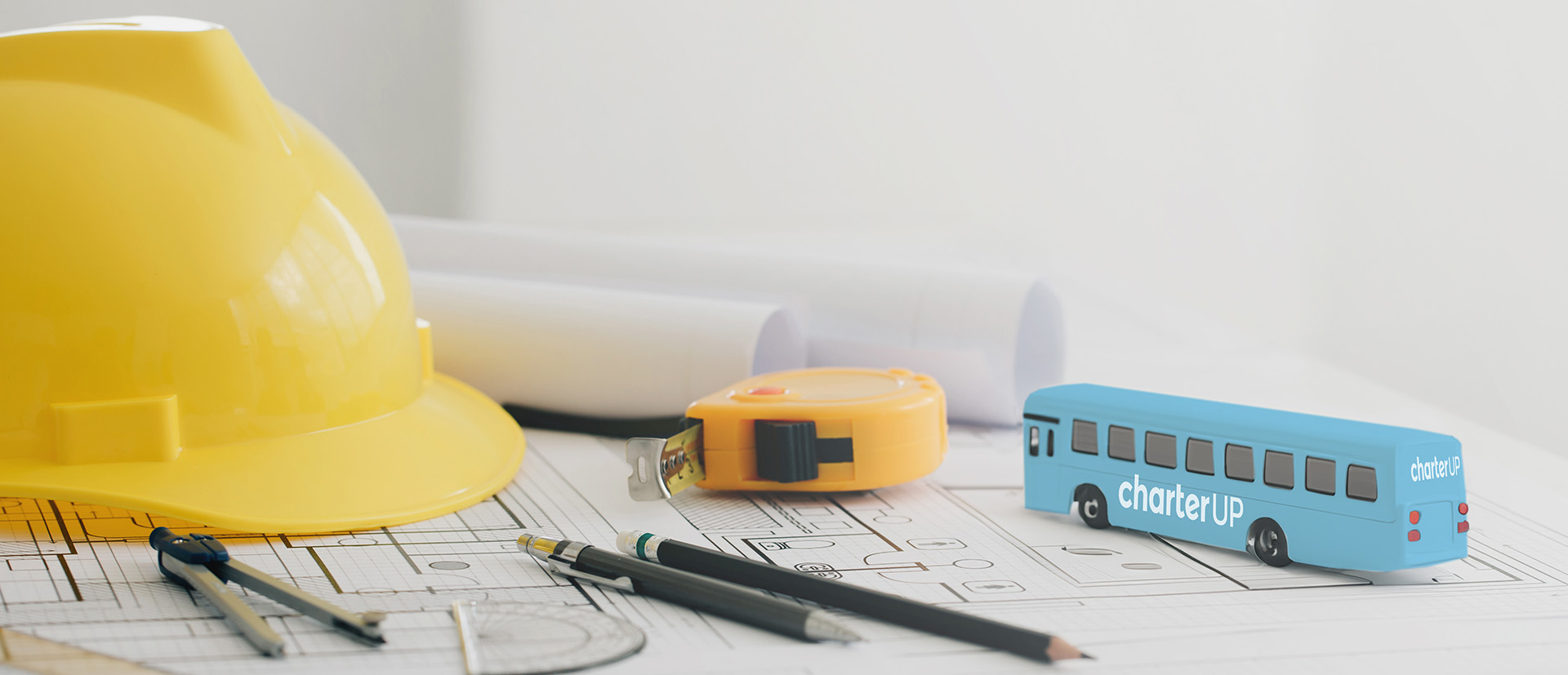Table Of Contents
For construction managers, every minute matters – including the ones wasted on the commute. Site congestion, unpredictable arrival times and rising parking costs create inefficiencies that ripple across the workday. At the same time, the environmental and financial impact of hundreds of separate trips to the jobsite adds up, eating away at project budgets and raising a site’s carbon footprint.
Coordinating transportation on a construction site is no easy feat. That’s where a strategic, reliable jobsite shuttle solution can transform the way you manage your workforce. Tailored shuttle services are designed to overcome the common obstacles of construction transportation, delivering benefits that can be felt across the project — from increased productivity to safer, more organized job sites.
Ready to Streamline Your Jobsite Transportation?
Contact us today for a quote and discover how CharterUP can streamline your construction transportation from day one.
This guide will break down how implementing a custom shuttle program can help your team stay focused, improve project efficiency and keep schedules on track — every single day.
Why Construction Projects Need Shuttle Solutions
Managing transportation for a construction project isn’t just about getting from point A to point B. Construction managers face a maze of logistical and budgetary headaches, from arranging parking to coordinating multiple sites. And while job sites often account for the cost of equipment and materials, worker commutes can become an overlooked budget-buster that spirals into time and cost inefficiencies. Here’s how shuttle services can change the game:
The Hidden Cost of Parking
For projects in urban or high-traffic areas, finding parking close to the site can be a nightmare. Between steep daily rates and limited availability, parking fees start as a small expense but soon turn into a budget sinkhole. It’s not uncommon for construction managers to go to lengths like paying their employees’ parking tickets just to keep workers focused on the job rather than on feeding meters. Over the course of a project, these accumulated parking costs — not to mention the added administrative overhead of managing them — can eat into already-tight budgets. A centralized shuttle solution saves managers from both the cost and the headache of parking logistics, keeping the project financially on track.
The Productivity Toll
Commutes don’t just cost money—they cost time and productivity. Workers struggling through traffic or scrambling for parking are often late, and even small delays can throw an entire project’s schedule off course. Add in the frequent traffic jams around urban or congested sites, and the result is a daily drain on valuable work time. With reliable shuttles transporting the crew in one coordinated trip, teams arrive together, on time and ready to start the day without delay. This time savings translates directly into improved productivity, helping keep projects on schedule and under budget.
Safety Beyond Hard Hats
Construction safety shouldn’t stop at the gate. After a long, physically demanding shift, the last thing workers need is to face a stressful commute home. Exhausted workers navigating the roads in the dark are at greater risk of accidents, especially in the early mornings or late evenings. A shuttle service eases this burden, providing workers with a safe, comfortable ride both to and from the site. This focus on holistic safety helps create a better work environment and reduces the risk of commute-related incidents.
With a shuttle service, construction managers can tackle these issues head-on, freeing up both time and resources to focus on the actual build. From cutting hidden costs to enhancing productivity and ensuring safety, worksite shuttles are a smart investment that pays dividends across the project’s lifespan
Use Cases for Construction Shuttles
From sprawling data centers to urban medical complexes, shuttles enhance efficiency, keep projects on schedule and simplify crew management. Here’s a closer look at how different project types can benefit from shuttle solutions:
High-Rise, High-Traffic Projects
These projects often rise in the heart of bustling cities, where parking is at a premium. Construction workers may have to park blocks away, taking valuable time just to reach the site. Additionally, high-rise projects require tight coordination to maintain safety and efficiency amid busy city environments. Shuttles can eliminate the need for multiple parking arrangements and ensure that workers arrive together and ready to work, reducing the potential for staggered start times.
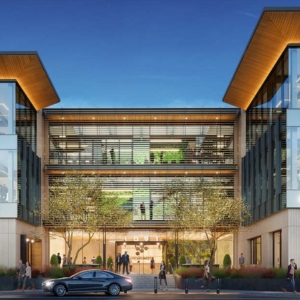
South Bay Construction
How CharterUP Steered An Urban Project To Completion Amid Parking Challenges
Read MoreData Centers
As hubs for the modern digital economy, data centers are often located outside urban centers, where space is abundant and land is affordable. However, their remote locations mean workers face long commutes with limited parking options. This can result in delays and lowered productivity. A shuttle service can consolidate these long trips, ensuring that crews arrive together, reducing the wear and tear on personal vehicles and minimizing the environmental impact of separate commutes.
Medical Complexes
Building a hospital or medical research facility often means working in dense urban areas with limited on-site parking. This poses logistical challenges as workers compete with city traffic and parking meters, increasing the likelihood of delays. With a shuttle solution, crew members can be transported from designated parking lots or transit hubs directly to the jobsite, reducing wasted time and allowing teams to stay on a precise schedule in an industry where delays can have serious financial and regulatory consequences.
Industrial and Warehouse Complexes
Industrial builds, such as warehouses or manufacturing plants, frequently occur on large plots of land with crews working in several different locations across the site. Coordinating multiple teams can become a logistical puzzle, especially when sites are sprawling and have limited central access points. Shuttles provide a streamlined transportation solution that can quickly move teams between parking areas and work zones, keeping operations running smoothly without the need for individual vehicles clogging up site roads.
Airport Expansions
Construction at airports involves navigating high-security zones, strict schedules and high-traffic areas. Getting crews through security and to the right locations without delay can be a challenge, especially as they move between terminals or around airstrips. Shuttles provide a centralized transportation option that ensures all crew members arrive on time and without individual cars crowding security lines, simplifying airport compliance and site access.
Solar Projects
Solar farms are typically large-scale installations located in remote, open spaces to maximize sunlight exposure. For example, a solar project covering thousands of acres in rural Arizona could require hundreds of workers, but with sparse nearby accommodations and minimal public transit options, getting to the jobsite is a challenge. Shuttles can provide an efficient, long-distance transport solution, bringing crews to the site from nearby towns or temporary housing and keeping projects moving smoothly.

Moss Construction
How CharterUP Helped Build Excellence in Massive Solar Energy Project
Read MoreFor each of these unique construction scenarios, worksite shuttles offer a custom-fit solution to overcome logistical challenges, keep crews coordinated and streamline project timelines.
Step-by-Step Guide to Launching a Construction Shuttle Program
Implementing a construction shuttle program requires careful planning and coordination to ensure the service aligns with your project’s specific needs.
Here’s a step-by-step guide to help you launch a successful shuttle program, whether you’re working with a national provider or a local transportation partner.
Step 1: Assess
Assess your project’s transportation needs:
- Evaluate Crew Size and Commute Patterns: Start by determining the number of workers who need transportation and where they’ll be coming from. Consider distances, estimated commute times and peak hours to understand the scale of service you’ll require.
- Identify Key Transportation Challenges: Examine common hurdles, such as parking limitations, traffic congestion or multiple worksite locations. This will help you tailor a shuttle program that addresses specific issues and avoids potential bottlenecks.
- Consider Project Duration: Knowing how long the project will last can influence decisions like contract length and flexibility. A short-term project may need a simpler setup, while a multi-year build might benefit from more customized, adaptable services.
Step 2: Identification
Research and select a shuttle provider:
- Assess Provider Experience and Fleet Variety: Look for a transportation partner with experience in construction projects, as they’ll understand the unique demands of jobsite shuttle services. Confirm they have a variety of vehicles (e.g., vans, minibuses, coaches) to accommodate different crew sizes and worksite layouts.
- Review Safety and Maintenance Standards: Make sure the provider adheres to strict safety protocols and maintains a well-serviced fleet. Safety is paramount on any jobsite, and reliable vehicles minimize the risk of breakdowns or delays.
- Request References or Case Studies: Ask for examples of similar projects they’ve managed, as this can give you confidence in their ability to handle your specific needs. Testimonials from other construction managers can also provide insights into the provider’s reliability and customer service.
Step 3: Plan
Develop a customized shuttle plan:
- Define Pick-Up and Drop-Off Locations: Choose central pick-up points that are accessible to workers and located in safe, convenient areas. For urban projects, consider offsite parking lots near major transit routes to streamline access.
- Establish Route Schedules and Frequency: Work with the provider to map out optimal routes, factoring in traffic patterns, crew start times and project phases. Some projects may require frequent shuttles during peak hours, while others may need flexible timing based on shifts.
- Ensure Flexibility for Project Changes: Construction projects can face schedule shifts or delays, so it’s wise to build flexibility into the shuttle plan. Discuss options for adjusting routes, adding more vehicles, or modifying schedules as project needs evolve.
Step 4: Prepare
Communicate and coordinate with your crew:
- Inform Workers About Shuttle Details: Clearly communicate the shuttle schedule, pick-up locations and any policies or safety procedures they need to follow. Ensuring your crew knows exactly where and when to meet the shuttle reduces confusion and improves punctuality.
- Set Up Real-Time Communication Channels: Consider using text alerts or a mobile app to keep workers informed about any schedule changes, delays, or route adjustments. Real-time updates enhance coordination and keep everyone on the same page.
- Emphasize Shuttle Benefits: Remind the team of the benefits, such as avoiding the hassle of parking, ensuring safe transportation and supporting project timelines. When workers understand the value of the service, they’re more likely to engage with the program.
Step 5: Monitor
Monitor and adjust the shuttle program as needed:
- Track Performance Metrics: Work with the provider to monitor key metrics, such as on-time performance, ridership levels and vehicle capacity utilization. These insights can help you identify areas for improvement and make data-driven adjustments to the program.
- Gather Feedback from Workers and Supervisors: Encourage feedback from the crew to understand their experience and any issues they may be facing. Workers may offer valuable insights into route efficiency, pick-up location convenience and overall satisfaction with the service.
- Review and Optimize Routes and Schedules: Based on performance data and feedback, periodically review routes, schedules and vehicle requirements. Adjust as necessary to ensure the shuttle program continues to meet the evolving demands of the project.
Step 6: Evaluate
Evaluate the ROI of the shuttle program:
- Compare Costs Against Savings: Assess the financial impact of the shuttle service by comparing its cost to the savings generated from reduced parking fees, fewer delays and improved productivity.
- Measure Productivity Gains: Evaluate how the shuttle program has affected worksite efficiency and productivity. Reduced commute stress, timely arrivals and fewer logistical distractions can translate into significant project benefits.
- Consider Environmental and Safety Impacts: Factor in the environmental benefits from reduced car usage and any improvements in worker safety. A well-run shuttle service supports a greener, safer and more efficient jobsite.
By following these steps, construction managers can establish an effective shuttle program that boosts efficiency, enhances safety and makes daily commutes easier for the crew.
Why CharterUP is a Trusted Construction Shuttle Provider
When it comes to choosing a shuttle provider for construction projects, CharterUP sets the standard with a blend of robust vehicle options, cutting-edge technology and a commitment to excellence.
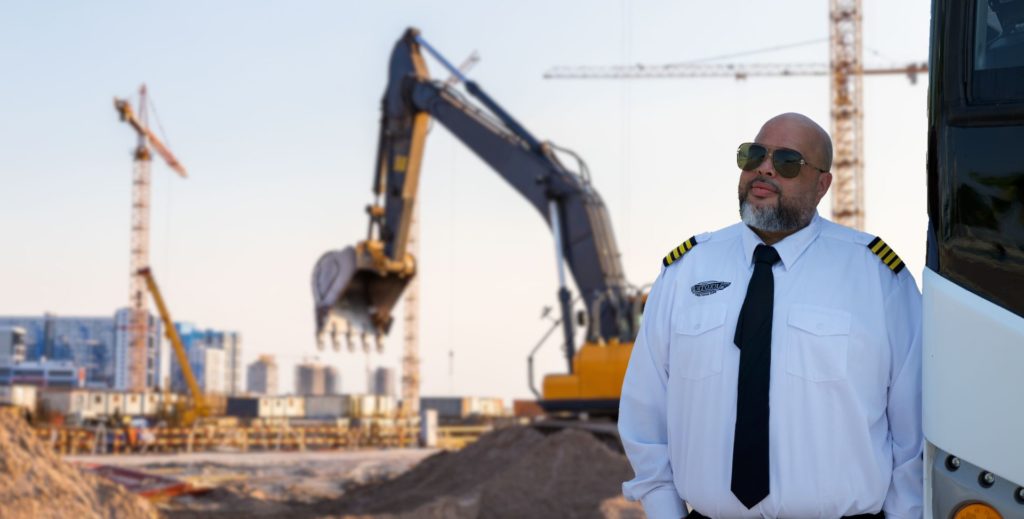
With a proven track record and a deep understanding of construction logistics, CharterUP offers a suite of services that streamline transportation and enhance overall project efficiency.
Extensive Fleet and Vehicle Variety
CharterUP boasts the nation’s largest charter fleet, with over 5,000 vehicles ranging from sprinter vans to full-sized coaches. This wide selection ensures that every construction project, regardless of scale or location, has access to the right transportation solution. Whether you need compact vehicles for urban projects or larger coaches for remote worksites, CharterUP can match your specific requirements, ensuring your crew travels comfortably and efficiently.
Optimized Routing and Advanced Coordination
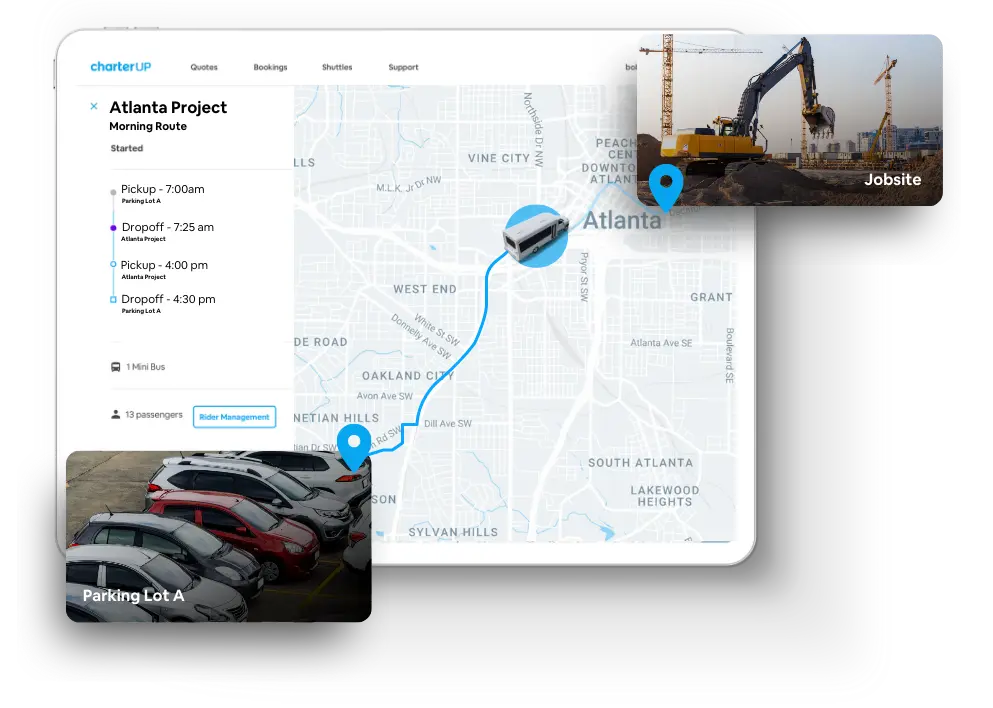
Navigating construction site logistics requires more than just vehicles — it demands strategic planning and real-time adaptability. CharterUP’s advanced route mapping technology optimizes travel paths to minimize delays and avoid traffic congestion, keeping your project on schedule. For multi-phase or multi-site projects, this means workers spend less time on the road and more time on the job, with shuttles seamlessly adjusting to your evolving needs.
Uncompromising Safety and Reliability
Professional drivers, well-maintained vehicles and strict adherence to safety protocols are non-negotiable elements of CharterUP’s service. The CharterUP platform provides insights into driver behavior and vehicle conditions, offering an extra layer of accountability and assurance that your crew is in safe hands from pick-up to drop-off.
End-to-End Support and Accountability
CharterUP goes beyond transportation by providing full-scale support throughout your shuttle program. From initial planning and route setup to daily operations and performance monitoring, their team is committed to seamless service execution. Detailed ridership data, trip histories and performance analytics offer transparency, empowering project managers with the information they need to make informed decisions. Dedicated account managers actively track key metrics, ensuring on-time performance and trip verification to maintain high standards and drive continuous improvement.
Cutting-Edge Shuttle Management Platform
CharterUP’s proprietary technology offers a comprehensive shuttle management solution that simplifies coordination and enhances oversight. Project managers can track shuttles in real-time, adjust schedules on the fly and monitor shuttle operations through a single, user-friendly platform. This level of control and visibility allows for quick decision-making and efficient communication with crews, minimizing disruptions and maximizing productivity.
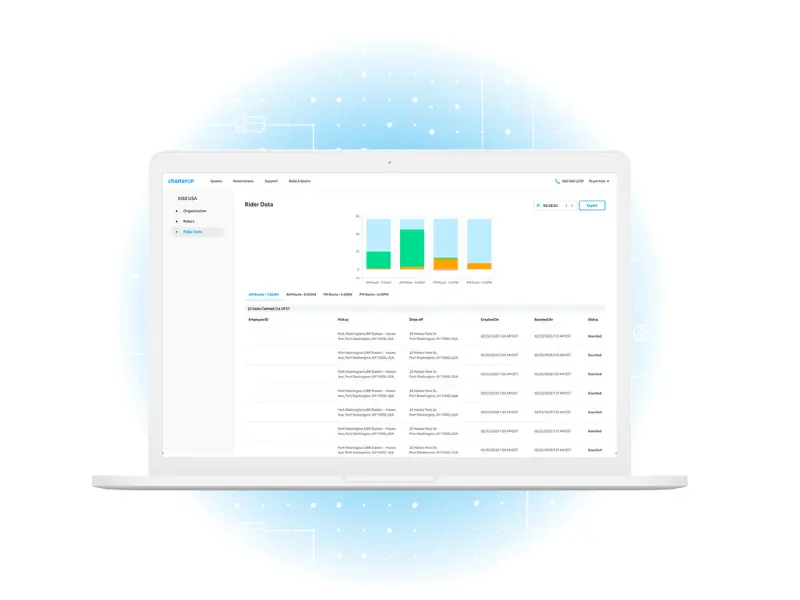
With CharterUP, construction companies gain a partner that not only understands the intricacies of worksite transportation but also delivers a reliable, transparent and efficient service. By integrating these comprehensive features, CharterUP transforms shuttle solutions into a strategic advantage, keeping projects on track and workers moving with confidence.
Ready to Streamline Your Jobsite Transportation?
CharterUP’s construction shuttle services are designed to take the stress out of worksite logistics, helping you keep your crew safe, on time and focused on the project at hand. From our extensive fleet and customized route mapping to real-time tracking and a rigorous commitment to safety, CharterUP provides an all-in-one solution that enhances productivity, reduces costs and simplifies day-to-day operations on any jobsite. With full transparency and support from initial planning through daily execution, our shuttles keep your project moving efficiently and on schedule.
Whether you’re still assembling a bid or gearing up to break ground, CharterUP’s construction shuttle experts are ready to deliver a transportation plan tailored to your needs. Contact us today for a quote and discover how CharterUP can streamline your construction transportation from day one.
